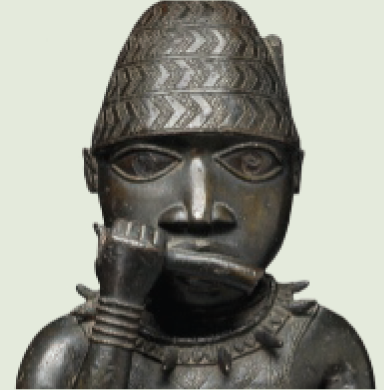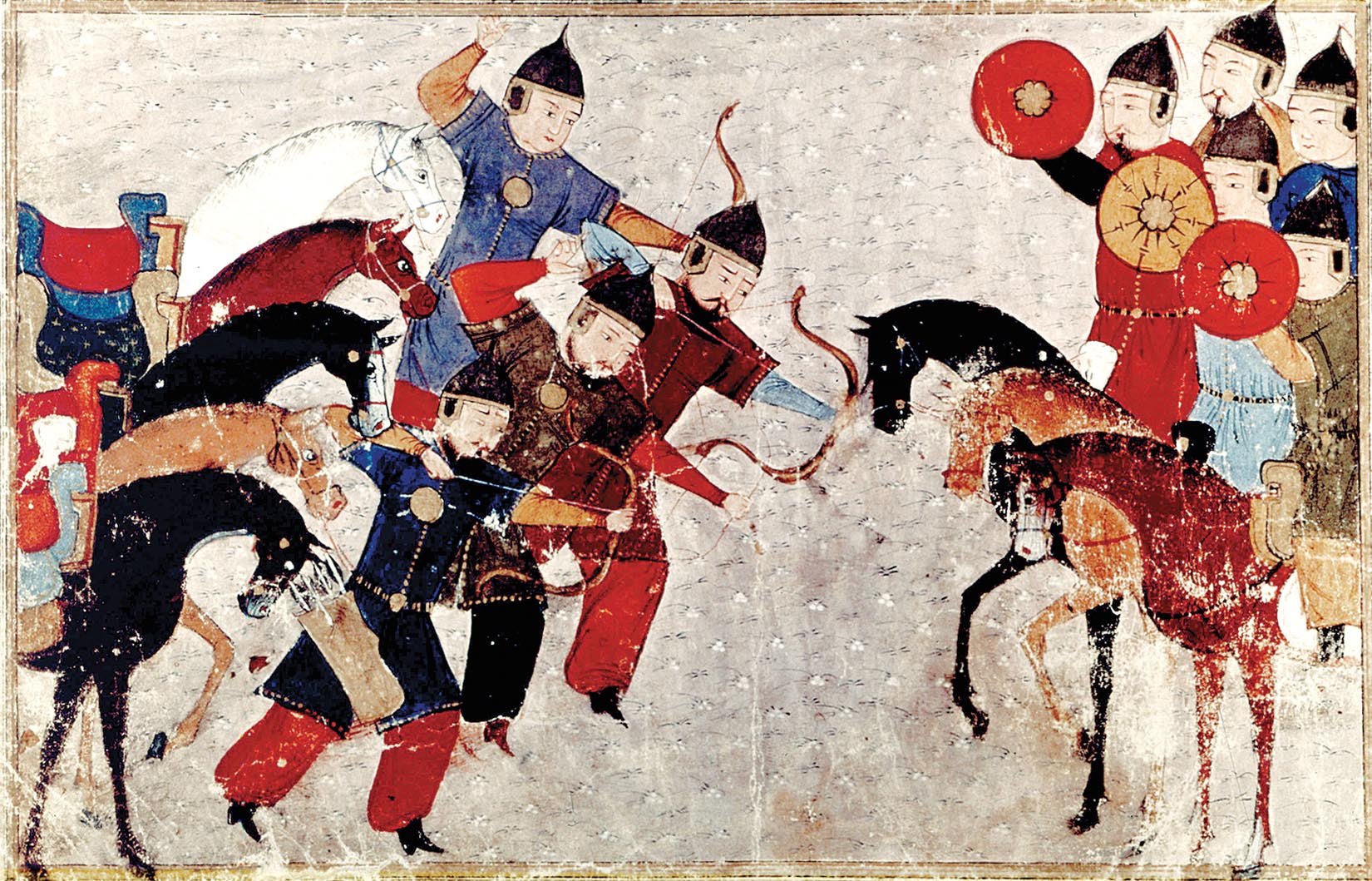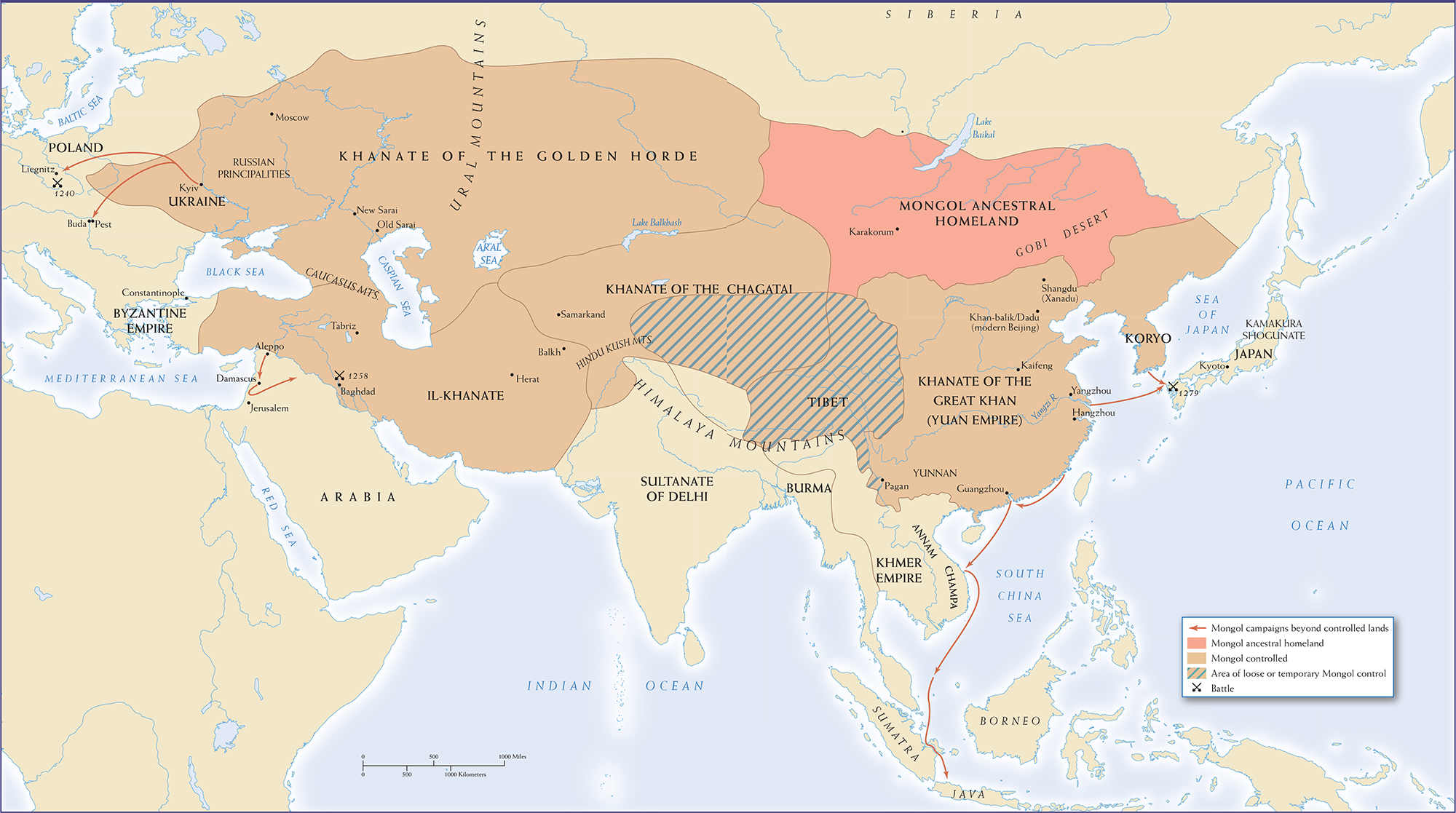A Most Unusual Nomad Empire
Although nomadic pastoralists and sedentary agriculturalists depended on each other to flourish, their deep commitments to their institutions and ways of life made cooperation difficult. Pastoralists endeavored to be as self-sufficient as possible. They scorned peoples who dug in the soil. On the other hand, as we noted in Chapter 3, sedentary peoples, most notably their literate members, regarded herders as uncivilized barbarians. The Chinese, for instance, saw the steppe peoples who lived to the north of them, and often invaded their state, as greedy, violent raiders from barbarian lands.
The Mongols were the quintessential pastoral nomads. Very little is known of their early history, largely because they were a small, fragmented, and powerless people living along the borderlands of southern Siberia, eastern Mongolia, and northwestern Manchuria. To their east lived the Tatars, and to their west the Uighurs and Khitai, far more powerful pastoral peoples from whom the Mongols learned many of their political and military skills. The Mongols first surface in Chinese sources during the Tang dynasty (618–907 CE). The Chinese, who feared the military capabilities of steppe peoples and were regularly invaded and even conquered by those peoples, had little fear of the Mongols at this time, regarding them as an insignificant community far from the empire’s northern frontier. The Mongols were well known, however, for raiding, looting, and violence toward outsiders and among themselves.
Few individuals have had a greater impact on world history than the founder of the Mongol state, Temüjin (c. 1162–1227). His youthful travails hardened him as a warrior and made him a leader. Having lost his father at a young age and being the eldest of his siblings, he, along with his mother, endured a harsh existence. But as an adult, he unified warring Mongol clans and defeated the Mongols’ enemies, either assimilating them to the Mongol way of life or exterminating them if they refused his leadership. In 1206, as a result of his spectacular military successes, he took the name Chinggis Khan, meaning “supreme ruler.” Not only did he bring most of Inner Asia under his rule, but his armies pushed southward into Manchuria and northern China and west toward central Asia and the Islamic states. At his death in 1227, he divided his vast territorial conquests among the four sons of his first wife, Börte. These men and their successors created four Mongol states, called khanates, loosely linked as an empire: Yuan China; the Khanate of the Golden Horde; the northern steppe (Khanate of the Chagatai); and Persia, known as the Il-Khanate.
The Mongols established and extended their rule over settled societies in China, Iran, central Asia, and part of the East Slavic lands, but then had to decide how to rule over sedentary populations. Specifically, the issue facing Mongol rulers was whether to foster close relations with the ruling classes of the conquered societies or stay apart, relying on military force. In truth, the Mongol Empire was fragmented and each state was ruled in manifestly different ways. Yet one quality underlay all the Mongol territories—the dominant presence of the Mongol military and the high prestige that was attached to being a Mongol. Commonly, pastoral nomads who conquered sedentary peoples kept their distance from those settled societies with their cities, bureaucracies, artisans, and priests, instead extracting tribute from them while maintaining their own distinctive way of life. For example, Chinggis forbade his followers to live in towns, and the Golden Horde Mongols lived separately from the peoples they conquered, maintaining their pastoral norms and content to receive tribute payments.
Early on, some of Chinggis’s followers wanted to annihilate the northern Chinese population and turn the region into pure pastureland. Ogodei, Chinggis’s third son and successor as the Great Khan, was opposed to Chinggis’s merciless and destructive practices and ordered his followers not to kill or loot indiscriminately. One of Ogodei’s successors, Kublai, became the founder of the Yuan dynasty in China (1279–1368), claiming for himself the Chinese mandate of heaven. Even so, Kublai cherished his Mongol identity, never learned Chinese, and never consulted a book in Chinese. Moreover, the Yuan rulers divided the populations under their rule into four ranked tiers: the first was the Mongols themselves; the second, the non-Han Chinese of the western parts of Inner Asia, mainly nomads like themselves; the third, the northern Chinese, conquered early in the Mongol expansion; and the fourth, the southern Chinese, once ruled by the Song dynasty and the center of Confucian culture. In such a fashion, the Yuan dynasty, although centered in China proper—the heartland of urbanization and high culture—did not allow itself to be swallowed up by the Han population or its culture.
Thus, the Mongol Empire, which lasted for more than two centuries, made an uneasy accommodation with sedentary populations, with its rulers partially embracing the institutions of the sedentary peoples, but never fully renouncing their pastoral, nomadic ways. In this way, they were able to create a Pax Mongolica, in which diverse peoples interacted across territory governed by conquerors.
QUESTIONS FOR ANALYSIS
- How did nomads and sedentary peoples view one another?
- Why might one consider the Mongols in general, and Temüjin in particular, to be unlikely conquerors?
- In what ways did different Mongol leaders negotiate the difference between pastoral and sedentary ways?
EXPLORE FURTHER
Di Cosmo, Nicola, Allen J. Frank, and Peter Golden (eds.), The Cambridge History of Inner Asia: The Chinggisid Age (2009).
Khazanov, Anatoly M., Nomads and the Outside World, 2nd ed., trans. Julia Crookurden, with a foreword by Ernest Gellner (1994).
Mote, Frederick W., Imperial China, 900–1800 (1999).
Rossabi, Morris, A History of China (2014).
Tanner, Harold M., China: A History (2009).
Weatherford, Jack, Genghis Khan and the Making of the Modern World (2004).


